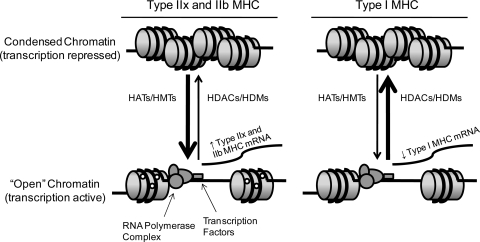Fig. 1.
Schematic representing epigenetic histone modifications occurring in the slow fiber-type soleus muscle in response to reduced muscular activity/unloading (hindlimb suspension). Upon induction of hindlimb suspension, histone acetylation and/or histone methylation (left), by histone acetyltransferases (HATs) and histone methyltransferases (HMTs), respectively, are associated with an “open” chromatin structure and increased transcriptional activity of type IIx and IIb myosin heavy chain (MHC) genes. On the other hand, histone deacetylation and/or histone demethylation (right), by histone deacetylases (HDACs) and histone demethylases (HDMs), respectively, are associated with a condensed chromatin structure and repressed transcriptional activity of the type I MHC gene in response to hindlimb suspension. ○, Acetyl or methyl groups covalently bound to histones.

